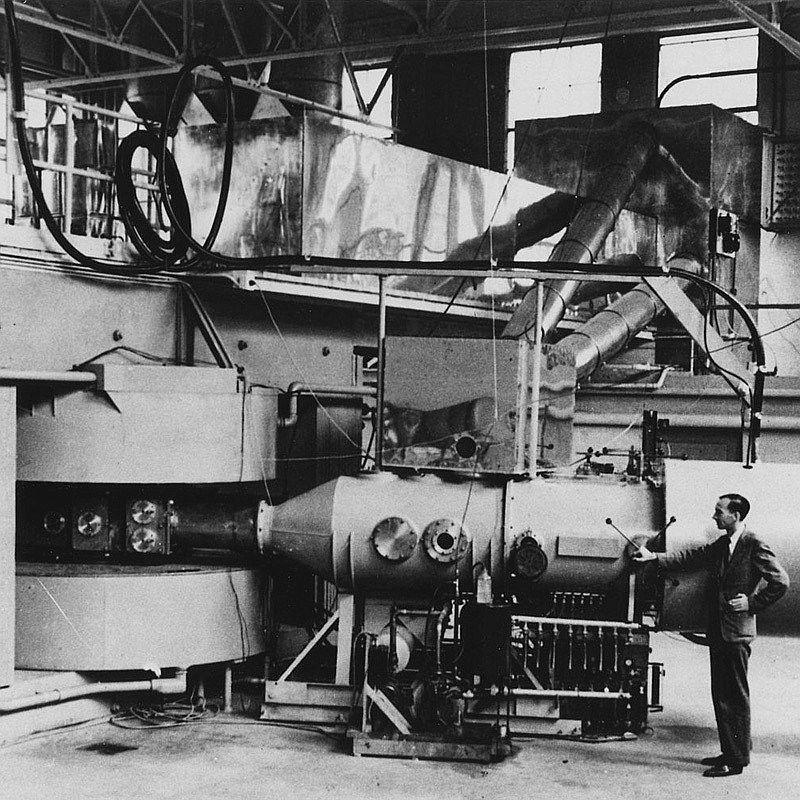Berkelium
97
Bk
Gruppe
n/a
Periode
7
Block
f
Protonen
Elektronen
Neutronen
97
97
150
Generelle Eigenschaften
Ordnungszahl
97
Atommasse
[247]
Massenzahl
247
Kategorie
Actinoide
Farbe
n/a
Radioaktiv
Ja
Named after Berkeley, California, the city of its discovery
Kristallstruktur
Einfach hexagonal
Geschichte
Berkelium was discovered by Glenn T. Seaborg, Albert Ghiorso and Stanley G. Thompson in 1949 at the University of California, Berkeley.
It was produced by the bombardment of americium with alpha particles.
Berkelium was isolated in greater quantities for the first time by Burris Cunningham and Stanley Thompson in 1958.
It was produced by the bombardment of americium with alpha particles.
Berkelium was isolated in greater quantities for the first time by Burris Cunningham and Stanley Thompson in 1958.
Elektronen pro Schale
2, 8, 18, 32, 27, 8, 2
Elektronenkonfiguration
[Rn] 5f9 7s2
Just over one gram of berkelium has been produced in the United States since 1967
Physikalische Eigenschaften
Aggregatzustand
Fest
Dichte
14,78 g/cm3
Schmelzpunkt
1259,15 K | 986 °C | 1806,8 °F
Siedepunkt
3173,15 K | 2900 °C | 5252 °F
Schmelzwärme
n/a
Verdampfungswärme
n/a
Spezifische Wärmekapazität
-
Häufigkeit in der Erdkruste
n/a
Häufigkeit im Universum
n/a

Danksagungen für Bilder: Wikimedia Commons (Department of Energy - Office of Public Affairs)
The 60-inch cyclotron at the Lawrence Radiation Laboratory, University of California, Berkeley
CAS-Nummer
7440-40-6
PubChem CID-Nummer
23971
Atomeigenschaften
Atomradius
170 pm
Kovalenter Radius
-
Elektronegativität
1,3 (Pauling-Skala)
Ionisierungsenergie
6,1979 eV
Molares Volumen
16,7 cm3/mol
Wärmeleitfähigkeit
0,1 W/cm·K
Oxidationszustände
3, 4
Anwendung
Berkelium is mainly used for scientific research purposes.
Berkelium-249 is a common target nuclide to prepare still heavier transuranic elements and transactinides, such as lawrencium, rutherfordium and bohrium.
It is also useful as a source of the isotope californium-249.
Berkelium-249 is a common target nuclide to prepare still heavier transuranic elements and transactinides, such as lawrencium, rutherfordium and bohrium.
It is also useful as a source of the isotope californium-249.
Berkelium is harmful due to its radioactivity
Isotope
Stabile Isotope
-Instabile Isotope
233Bk, 235Bk, 236Bk, 237Bk, 238Bk, 239Bk, 240Bk, 241Bk, 242Bk, 243Bk, 244Bk, 245Bk, 246Bk, 247Bk, 248Bk, 249Bk, 250Bk, 251Bk, 252Bk, 253Bk, 254Bk